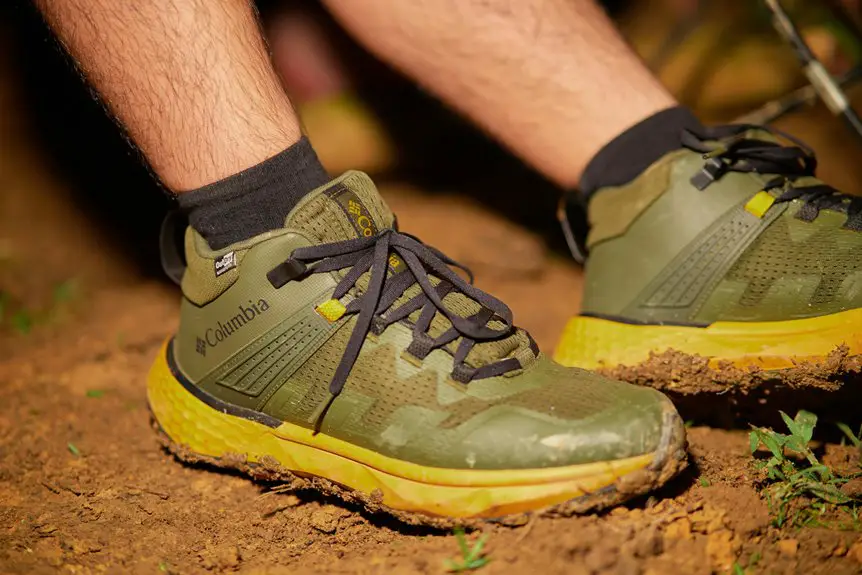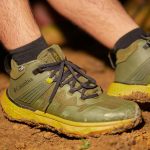To restore the waterproofing on your Gore-Tex boots, first check if water beads or soaks in, indicating diminished protection. Clean your boots gently with mild soap and lukewarm water, avoiding harsh chemicals. Choose a waterproofing spray or wash-in treatment compatible with Gore-Tex, then apply it evenly, focusing on seams and worn areas. Let your boots dry naturally, away from direct heat. Keep moisture out by maintaining this routine, and you’ll find more tips to keep your boots performing at their best.
Table of Contents
Key Takeaways
- Clean boots with mild soap and lukewarm water, removing dirt without damaging the Gore-Tex membrane.
- Ensure boots are fully dry before applying any waterproofing treatment.
- Use a Gore-Tex compatible spray or wash-in waterproofing product, avoiding heavy waxes or oils.
- Apply a light, even coat focusing on seams and high-wear areas for effective coverage.
- Dry boots naturally after treatment, avoiding direct heat or sunlight to preserve waterproofing.
Assessing the Waterproofing Condition of Your Boots
How do you know when your Gore-Tex boots have lost their waterproofing? The easiest way is to check if your feet feel damp or wet after walking through wet conditions.
You’ll know your Gore-Tex boots have lost waterproofing if your feet feel damp after wet walks.
You can also perform a simple water test: sprinkle water on the boot’s surface and see if it beads up and rolls off. If the water soaks in or leaves dark patches, the waterproofing is compromised.
Look closely for signs like worn-out seams, creases, or areas where the fabric looks rough or faded. These can indicate the DWR (Durable Water Repellent) coating has worn off.
Paying attention to these signs lets you decide when it’s time to restore your boots’ waterproofing to keep your feet dry and comfortable.
Cleaning Your Gore-Tex Boots Properly
Before restoring the waterproofing, you need to clean your Gore-Tex boots properly to remove dirt, oils, and old treatments that can block water repellency.
Start by removing the laces and brushing off loose dirt with a soft brush. Use a mild soap specifically designed for waterproof footwear or a gentle detergent mixed with lukewarm water. Avoid harsh chemicals or detergents that can damage the membrane.
Dip a soft cloth or sponge into the solution and gently scrub the entire boot, paying attention to seams and crevices. Rinse thoroughly with clean water to remove all soap residue.
Let your boots air dry at room temperature, away from direct heat or sunlight. Proper cleaning guarantees the waterproofing treatment will adhere effectively when applied.
Selecting the Right Waterproofing Treatment
You’ll want to choose a waterproofing treatment that matches your Gore-Tex boots’ materials to keep them breathable and effective.
Some products work better on leather, while others suit synthetic fabrics.
Picking the right one helps maintain your boots’ performance without causing damage.
Waterproofing Treatment Types
When choosing a waterproofing treatment for your Gore-Tex boots, you need to evaluate the type of material and the conditions you’ll face.
Generally, waterproofing treatments come in two main types: sprays and washes. Sprays are easy to apply and great for targeted areas, providing a durable water-repellent (DWR) finish that helps water bead off the surface.
Wash-in treatments, on the other hand, restore waterproofing throughout the entire boot and are ideal if your boots have lost overall water resistance. Some treatments include added conditioners to maintain flexibility.
Avoid heavy waxes or oils, as they can clog the Gore-Tex membrane, reducing breathability. Choose a treatment designed specifically for waterproof fabrics to maintain your boots’ performance in wet conditions.
Material Compatibility Considerations
Although selecting a waterproofing treatment may seem straightforward, matching it to your Gore-Tex boots‘ specific materials is crucial for effective protection. Your boots often combine leather, fabric, and synthetic components, each requiring a compatible product.
For leather sections, choose treatments designed to nourish and protect without causing stiffness or discoloration. Fabric areas need water repellents that maintain breathability and flexibility. Avoid oil-based products on Gore-Tex membranes, as they can clog pores and reduce performance.
Always check the treatment’s label for material compatibility and test on a small, hidden area first. By selecting the right waterproofing treatment tailored to your boots’ materials, you guarantee long-lasting durability and maintain the Gore-Tex membrane’s breathability and waterproofing capabilities effectively.
Applying Waterproofing Products Effectively
Applying waterproofing products effectively requires careful preparation and attention to detail.
First, verify your boots are clean and dry before you begin—any dirt or moisture will prevent the product from adhering properly.
Shake the waterproofing spray or shake the liquid thoroughly to mix the ingredients. Hold the spray about six inches from the boot’s surface and apply an even, light coat, focusing on seams and high-wear areas.
For liquid waterproofing, use a sponge or cloth to apply a thin, uniform layer. Avoid over-saturating; too much product can clog the Gore-Tex membrane.
Work methodically, covering every section without missing spots. Remember, consistent application is key to restoring water repellency and extending your boots’ lifespan.
Drying and Curing Your Boots
Since waterproofing products need time to bond effectively, you’ll want to dry and cure your Gore-Tex boots properly before wearing them. Rushing this step can reduce the product’s effectiveness and leave your boots vulnerable to moisture.
Follow these key steps:
- Air-dry your boots at room temperature; avoid direct sunlight or heat sources like radiators to prevent damage.
- Stuff the boots with newspaper or paper towels to absorb moisture and maintain their shape.
- Allow at least 12 hours for the waterproofing treatment to cure fully.
- After drying, check for any stiff or uneven spots, and gently flex the boots to guarantee the product has settled correctly.
Proper drying and curing enhance your boots’ waterproof barrier, guaranteeing reliable protection on your next adventure.
Maintaining Waterproofing for Long-Lasting Protection
To keep your Gore-Tex boots performing their best, you need to clean them properly without damaging the materials.
Regularly reapplying a durable water repellent helps maintain that essential waterproof barrier.
Finally, make sure you dry your boots correctly to preserve their protective qualities over time.
Cleaning Techniques
Keeping your Gore-Tex boots clean is essential for maintaining their waterproofing and ensuring they last through countless adventures. Dirt and grime can clog the membrane, reducing breathability and water resistance.
To clean your boots effectively:
- Remove laces and insoles to clean every part thoroughly.
- Brush off loose dirt with a soft brush or cloth.
- Use lukewarm water and a mild soap or specialized cleaner, avoiding harsh detergents.
- Rinse thoroughly to remove all soap residue, which can impair waterproofing.
After cleaning, let your boots air dry away from direct heat to prevent damage.
Regular, gentle cleaning keeps the Gore-Tex membrane functioning at its best and prepares your boots for reapplying water repellent treatments.
Reapplying Durable Water Repellent
Revive your Gore-Tex boots’ water resistance by reapplying a Durable Water Repellent (DWR) coating regularly. This simple step restores the fabric’s ability to shed water, keeping your feet dry and comfortable. Choose a spray-on or wash-in DWR treatment designed for Gore-Tex, and apply it evenly to clean, damp boots. Let the boots air dry before use. Regular reapplication extends your boots’ life and performance.
| Feeling | Reason |
|---|---|
| Confidence | Boots stay dry longer |
| Comfort | No soggy socks or feet |
| Trust | Reliable protection |
| Satisfaction | Easy upkeep |
| Pride | Well-maintained gear |
Keep your Gore-Tex boots performing their best by staying on top of DWR treatments.
Proper Drying Methods
After reapplying Durable Water Repellent, how you dry your Gore-Tex boots can make a big difference in maintaining their waterproof performance.
To protect the membrane and guarantee long-lasting protection, follow these proper drying methods:
- Air dry at room temperature – Avoid direct sunlight or heat sources that can damage materials.
- Remove insoles and loosen laces – This promotes airflow inside the boots, speeding up drying.
- Use a boot dryer or stuff with newspaper – Both help absorb moisture without overheating the boots.
- Avoid using a tumble dryer or direct heaters – Excessive heat can break down waterproof coatings and deform the boots.
Following these steps keeps your boots in top shape, preserving their waterproofing and comfort for your next adventure.
Frequently Asked Questions
Can I Use Regular Shoe Polish on Gore-Tex Boots?
You shouldn’t put all your eggs in one basket by using regular shoe polish on Gore-Tex boots. It can clog the membrane. Instead, use products made specifically to protect Gore-Tex’s waterproofing and breathability.
How Often Should I Replace the Insoles in Gore-Tex Boots?
You should replace the insoles in your Gore-Tex boots every 6 to 12 months, depending on wear and odor. If they lose cushioning or smell bad, it’s time to swap them out for fresh comfort.
Are Gore-Tex Boots Suitable for Winter Hiking?
You want warmth, you want dryness, you want comfort—Gore-Tex boots deliver all three for winter hiking. They keep moisture out, breath well, and insulate you, making them a solid choice for snowy, chilly trails.
Can I Wear Gore-Tex Boots in Extreme Heat?
You can wear Gore-Tex boots in extreme heat, but they might feel less breathable and cause your feet to sweat more. It’s better to choose lighter, more ventilated footwear for hot conditions to stay comfortable.
Do Gore-Tex Boots Require Special Storage Conditions?
You don’t need special storage for Gore-Tex boots, but you should keep them in a cool, dry place away from direct sunlight and heat. Let them dry naturally before storing to maintain their waterproofing and material integrity.
- Does Chiffon Fabric Stink - July 15, 2025
- Does Chiffon Fabric Affect the Economy - July 15, 2025
- Does Cotton Fabric Have a Nap - July 15, 2025







